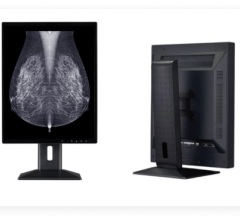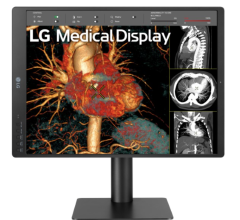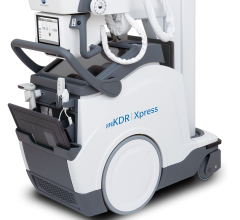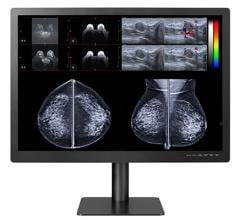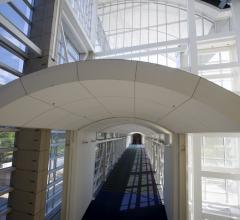Well before flat-panel televisions became all the rage in the consumer market, healthcare facilities began singing the praises of the ultra-thin displays that tout eye-popping visual clarity.
And as the costs of flat-panel medical grade and general-use displays have dropped considerably, manufacturers are now competing for buyers’ hearts and minds on a host of issues such as image quality and connectivity. Today, sophisticated buyers are talking contrast ratio, pixels and processing speeds.
According to Plymouth Meeting, PA-based ECRI, a nonprofit health services research agency, active matrix liquid crystal displays (LCDs) have a host of benefits over traditional cathode ray tube (CRT) displays, including less energy consumption (between 30 to 50 percent less), brighter images, higher spatial resolution, good contrast in a smaller footprint and virtually no glare.
“For so long, CRT was the standard for medical imaging, and many believed it to be a stable platform,” said Joey Sanchez, marketing specialist at Cypress, CA-based Eizo Nanao Technologies Inc. Now that LCDs have surpassed CRTs in image quality, those perceptions have dramatically changed, he added.
In general, manufacturers are developing remarkable displays that take advantage of tinier, yet more muscular, video cards in order to exploit the promise of multidimensional diagnostic imaging modalities. Some observers say flat panels have become so good, they almost are overkill in the outpatient diagnostic imaging arena where a substantial amount of secondary reads are performed. Said one supplier executive who asked not to be identified: “Screen resolution is not as big a deal in the outpatient market as it is inside hospitals. Applications such as ultrasound don’t need high-resolution, high-end monitors, and I’m not sure some buyers understand that.”
Still, as the pile of unwanted CRT boxes gets higher and higher, there’s no quelling the demand for flat panels among increasingly savvy buyers in the outpatient arena. Kenzo Sudo, a spokesperson for Fremont, CA-based Advan International Corp., told Outpatient Care Technology that approximately 40 percent of outpatient care facilities have converted entirely to flat panel displays. According to Lynda Domogalla, marketing manager for Barco Medical Imaging Systems, Duluth, GA, virtually every display sold for diagnostic imaging in the outpatient arena today is a flat panel.
“LCDs have been delighting a growing medical imaging audience for years,” noted Katherine Shariq, an industry analyst with Frost and Sullivan’s Enterprise Communications Group. “The crispness of the image and the wide viewing angle of the screen have made it easier for the radiology technologist to find and capture the best image, while radiologists appreciate the fine gradation of grays.” Shariq added that even the field of mammography, “one of the last bastions for high-end CRT-based displays, has acquiesced to a gradual adoption of flat-panel displays following the recent FDA approval of the 5 megapixel high resolution screens for diagnostic analysis.”
Todd Fender, product line manager-specialty marketing for NEC Display Solutions of America, Itasca, IL, indicated global CRT production has declined so dramatically that no one is investing in developing new CRT technology. “It had a good 100-year run,” he noted. Concurrently, price points for LCDs have rapidly declined over the last two years, making even the larger sized LCDs (19 inches and larger) affordable, Fender added. “Coupled with the other benefits that LCDs provide, such as space and weight savings, no magnet to interfere with other equipment and reduced eyestrain, LCD displays are very common today.”
Rapid rate of innovation
Innovation is happening at such a rapid clip, it’s dizzying. And the field of major LCD suppliers to the outpatient care arena is busy. NEC, for example, will soon unveil its “900” series MultiSync LCD line that boasts more than 30 new innovations, Fender said. “These are the most intelligent displays in the world,” he added.
What are buyers looking for in flat panels today? Here’s a look.
Image quality. Affordability is nice, but buyers are becoming increasingly picky about the quality of the image. In most cases, LCDs do not disappoint. “Buyers today are primarily concerned about worry-free, consistent image quality for the life of the display,” said Domogalla. “They want to know that the display conforms to the DICOM standard and they don’t want to invest a lot of time and resources in maintaining the quality of the display.”
Indeed, LCDs are wowing clinicians in specialty areas such as cath labs, according to Shariq. “The shift from low-resolution, analog image intensifiers to digital flat panel detectors is making a difference in catheterization labs across the country,” she said. “Removing the analog-to-digital conversion step with a direct digital-to-digital signal has led to an improvement in the speed and resolution of the image.”
One measure of image quality is resolution, generally a measure of pixel density (from 1 to 5 megapixels). For such applications as review workstations and patient monitoring, for example, lower resolution displays are suitable. According to Domogalla, 2-megapixel displays are common for such applications as magnetic resonance and ultrasound, while 5-megapixel displays are called for in chest imaging and mammography. Multi-modality workstations, meanwhile, commonly use 3-megapixel displays, she added. “Screen resolution requirements do, for the most part, depend on the application, and are more critical in some medical applications than others,” said Fender. Modalities such as CT, MR and ultrasound require differing resolutions, as well as grayscale and color LCDs, depending on their applications, he added.
Still, resolution is only part of the equation as far as image quality, according to ECRI. “Current data supports the belief that display of radiographic images is more dependent on contrast than spatial resolution,” ECRI said. “While this may be an important buying consideration, it is always important to compare images side-by-side utilizing test patterns along with medical images to evaluate performance.”
Improved response times. In the early days, LCDs suffered from image processing lags, or the amount of time required for a pixel to go from one gradation or color to another. But that is changing. For example, rapid response times (typically in the area of 35 to 40 milliseconds) have made LCDs increasingly popular in ultrasound, Shariq said. “Response time is a critical component in ultrasound,” she said. “The screen must have rapid refresh and response rates to produce an accurate real-time representation of the organ or fetus being viewed.” Shariq added that LCDs may soon tout response times as low as 16 milliseconds.
Consistent brightness. Buyers also are sticklers about brightness, a factor that is increasingly critical in diagnostic applications such as mammography. Manufacturers have responded with many innovative solutions. According to ECRI, many flat panels do not have color filters and rely on an illumination source for color temperature, or hue. Many use fluorescent-type tubes. NEC recently unveiled its MultiSync LCD2180WG, what it dubbed as the world’s first LCD with an LED backlight desktop display that boasts a broad color gamut without loss of luminance. “We believe that LEDs as a backlight source for LCDs are the future, and the healthcare market and even niche markets like radiology will be one of the early adopters of this technology,” Fender said. As a criterion, brightness also has to be consistent. Early LCDs often suffered from drop-outs in brightness or “white points.” At the 2005 RSNA conference, Barco introduced a new generation of its Coronis display systems featuring “Uniform Luminance Technology” to correct for non-uniformities in the LCD display and backlight. Eizo Nanao Technologies’ displays boast “brightness stabilization” for consistently bright images, 14-bit grayscale and color processing that allows for more accurate representation of colors on screen, and a proprietary uniformity equalizer that allows for a consistency across the entire screen, Sanchez said.
Calibration. Because of their sophisticated electronics, LCDs can quickly fall out of tune. Manufacturers have responded with innovations that keep LCDs properly and automatically calibrated; some models can even be calibrated remotely. According to Shariq, CRT-based displays often start to drift out of focus after a year and a half and require regular calibration for the next three to four years. Thanks to advancements in automated calibration, LCDs today offer greater performance than ever. “Freed from manual calibrations, PACS administrators should see efficiency gains as they adopt the centralized calibration features,” Shariq added. Barco’s Coronis products, for example, feature an “I-Guard” front-of-screen sensor and MediCal software that work in tandem to assure intervention-free QA and DICOM calibration, Domogalla said. The company also offers a web-based service for transparent calibration and QA.
Plug and play. As with so much technology today, buyers demand equipment that plays well with others. LCD manufacturers are listening. “Buyers are looking for a monitor that they can plug and play and don’t have to mess around with too much or very often,” said Sanchez. “They want something that is reliable and consistent, with as little maintenance as possible.” Morgan Hill, CA-based National Display manufactures all of its LCDs with a custom BIOS feature, which automatically adjusts to any device to which it is connected, said Ken Compton, regional manager. Barco’s plug-and-play solution converts the legacy user’s existing system over to a PIN-compatible 2-megapixel LCD and the user-friendly upgrade wizard takes the effort out of the conversion, Shariq added.
Connectivity. In the same vein, buyers today demand LCDs that easily interface, in some cases wirelessly, with PACS and other systems. Shariq added that networked referral displays located outside of PACS are finding new converts. “Referral displays are increasingly being networked into the PACS system, allowing physicians to access critical medical images for diagnostics or reference,” she said.
Flexibility, portability. Because of their smaller footprint and lighter weight, LCDs today can be mounted on walls and even carts, making them increasingly attractive in outpatient settings. In addition, most LCDs can be configured for multi-head applications and rotated (portrait vs. landscape) to allow for different viewing options. NEC, for example, has been “very successful” in marketing and selling its large-screen (from 32 to 46 inches and larger) LCDs to outpatient facilities, Fender said, because they can easily be mounted to rolling carts “and can be shared assets, instead of fixed in one location.”
What shapes buying decisions?
LCD manufacturers are competing less on price than key differentiation factors such as grayscale palette, calibration software, digital interface/communications and service, according to ECRI.
Indeed, many LCD suppliers are offering all kinds of incentives to ease purchase decisions. “Some CRT-based display monitor manufacturers are offering upgrade kits to enable existing medical CRT-based end users to easily upgrade a flat-panel display, replete with quality assurance management software,” said Shariq.
For savvy buyers, however, buying on price alone could be full of pitfalls.
“There still are many healthcare facilities, many of whom are our customers, who are less price sensitive than others because they see the value in purchasing the highest quality products available and products that have the built-in feature-set that they desire,” said Fender. “They believe that they are conveying an image of quality and performance to their customers (patients) and that they feel a need to back the image up with products that stand for the same level of commitment and quality.”
Domogalla noted, “For outpatient facilities in particular, price is important. However, they are concerned not only about the initial purchase price, but the cost to maintain the quality of the product over time.” She acknowledged that many outpatient care facilities and smaller hospitals often don’t have resources dedicated to maintaining the diagnostic quality of their PACS systems. “Features that assure product quality for the lifetime of the display have real value for these customers,” she said. “Outpatient care facilities generally don’t have many diagnostic PACS workstations, so flexibility in the display system is also important to them.”
But budgets are trying hard to keep pace with features. “Price will always be a factor when dealing with any facility that has to remain on budget, but features are continuously growing as more people begin to understand LCD technology,” added Sanchez. “Durability and consistency is starting to become a factor in their [buying decisions], as well as ease of use.”
Some say facilities should carefully consider whether buying LCDs as part of an equipment package is a wise move.
“Unfortunately, we believe that many healthcare buyers are accepting the flat-panel monitor that comes bundled with a PC,” said Fender. “It may be easier for the purchasing agents to acquire the product on one purchase order than it is to buy the peripheral components separately. They are virtually stuck with the display that is offered with the system, and most of the time, the display may not be of the best quality or may not have the feature set that can maximize their effectiveness or efficiency.”
© Copyright Wainscot Media. All Rights Reserved.
Subscribe Now

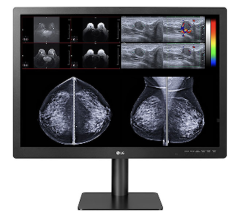
 March 12, 2024
March 12, 2024 
